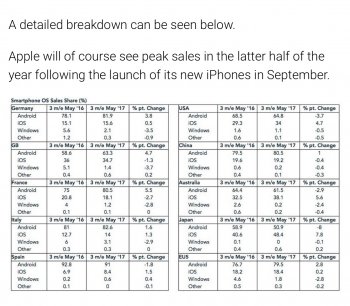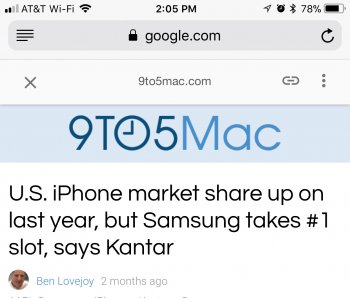First of all, this is not an “Apple Is Doomed™” post, just some food for thought.
One of the more well-known parts of the story of how Steve Jobs turned Apple around when he returned to the company in 1997 was how he radically cut the number of products the company was producing. At its peak before Jobs’ return, Apple had 350 ongoing projects. He cut that number to 10. Jobs himself explained it best at WWDC in 1998:
This year, Apple introduced two new families of iPhones (8 and 10) and also kept the 6S in the lineup, bringing the total number of iPhone families to five (SE, 6S, 7, 8, and X), as well as several sub families of regular and plus models. It got me thinking about bloat in the product line, something I think has been creeping back in pretty steadily since Jobs passed away in 2011. To be sure, Apple grew in the 2000s under Jobs as it moved into new product categories (iPod, iPhone, iPad). But, within each category, it remained relatively focused with only a handful of models.
I decided to do a little research on how the number of iPhone SKUs Apple sells has changed over time. Even though I was aware of how the product line has grown, the results surprised me. I did two calculations. The first was counting the number of SKUs a consumer sees, which includes the iPhone family and size (6S, 6S+, 7, 7+, etc.) plus the color plus the storage capacity. This method does not account for variations in cellular radios (which the average user does not care about). The second count includes all the variations in cellular radios (which jacks up the number of SKUs quite a bit when we hit the LTE era) and shows a bit more of the manufacturing requirements on Apple’s end. Note that these numbers are the SKUs available at the iPhone launch event each year. So, they don’t account for mid-year changes like the introduction of the CDMA iPhone 4 in 2011, the launch of the iPhone SE in March 2016, or the Product (RED) iPhone 7 earlier this year.

This chart blew me away. The number of iPhone SKUs visible to the consumer was never higher than 9 when Jobs was alive. Today, there are 60(!!!) different combinations for the consumer to choose from. Also, the products are named somewhat confusingly. What does SE stand for? Is it related to the 6S? Is the iPhone 8 better than the iPhone 7 Plus? Why isn’t there an iPhone 9? Admittedly, the names of the iPhone lines were somewhat confusing even when Jobs was at the helm. But, I have to imagine the average Apple customer is at least a little confused when browsing the Apple store website.
When you account for different SKU variants, the numbers are even more jarring. Clearly, the move to LTE in 2012 created new production challenges for Apple due to variations in the technology around the world. Going from a single “world phone” with the iPhone 4S, there were three different cellular variants of the iPhone 5, and seven variants of the 5C and 5S (thus the jump in SKUs in 2013). Apple started to get the number of cellular models back under control with the iPhone 6 in 2014 (only four variants). But, starting in 2016, Apple started keeping more models in the lineup, driving that number of SKUs back up.
Why is all this bad? First, it creates confusion for the consumer. If you follow Apple closely, and pour over the spec sheet comparisons on their website, it is possible to figure out the differences between the various iPhone models. But for the average consumer, the matrix of iPhone possibilities has to be a bit intimidating. Is the Neural Engine in the A11 chip worth forking over $150 over the A10 in the iPhone 7? How about the wide color display in the 7? Is that a significant upgrade over the 6S?
The second issue is it creates a huge manufacturing challenge for Apple. They now have to estimate demand for 216 different SKUs. How many people are going to want a gold iPhone 7 32 GB on a GSM network in North America vs CDMA? How about 128 GB vs 32 GB? I’m sure it’s not entirely to blame, but I have to imagine having so many SKUs at least partially contributes to the supply problems that accompany every iPhone launch.
Now, I am fully aware that the situation of Apple today is not the same as it was in 1997. For one, Apple is now one of the most profitable companies in the world, thanks in large part to a decade of iPhone sales. So, clearly consumers aren’t being driven away from the company by this situation. On the other hand, 60 different SKUs is starting to seem like bloat in the product line to me. If that’s a sign that Apple is starting to lose focus (there are other signs from around the company that it is), that’s not a good state of affairs over long-term. Tim Cook has done a great job at driving sales numbers. But, I am really starting to worry Apple is not positioning itself well for the future.
Anyway, just my (rather lengthy) two cents. I found this analysis interested and figured I’d share. What does everyone else think?
One of the more well-known parts of the story of how Steve Jobs turned Apple around when he returned to the company in 1997 was how he radically cut the number of products the company was producing. At its peak before Jobs’ return, Apple had 350 ongoing projects. He cut that number to 10. Jobs himself explained it best at WWDC in 1998:
What I found when I got here was a zillion and one products. [...] It was amazing. And I started to ask people, why would I recommend a 3400 over a 4400? Or when should somebody jump up to a 6500, but not a 7300? And after three weeks, I couldn’t figure this out! And I figured if I can’t figure it out working inside Apple with all these experts telling me into it, how are our customers going to figure this out?
Steve Jobs at WWDC 1998
This year, Apple introduced two new families of iPhones (8 and 10) and also kept the 6S in the lineup, bringing the total number of iPhone families to five (SE, 6S, 7, 8, and X), as well as several sub families of regular and plus models. It got me thinking about bloat in the product line, something I think has been creeping back in pretty steadily since Jobs passed away in 2011. To be sure, Apple grew in the 2000s under Jobs as it moved into new product categories (iPod, iPhone, iPad). But, within each category, it remained relatively focused with only a handful of models.
I decided to do a little research on how the number of iPhone SKUs Apple sells has changed over time. Even though I was aware of how the product line has grown, the results surprised me. I did two calculations. The first was counting the number of SKUs a consumer sees, which includes the iPhone family and size (6S, 6S+, 7, 7+, etc.) plus the color plus the storage capacity. This method does not account for variations in cellular radios (which the average user does not care about). The second count includes all the variations in cellular radios (which jacks up the number of SKUs quite a bit when we hit the LTE era) and shows a bit more of the manufacturing requirements on Apple’s end. Note that these numbers are the SKUs available at the iPhone launch event each year. So, they don’t account for mid-year changes like the introduction of the CDMA iPhone 4 in 2011, the launch of the iPhone SE in March 2016, or the Product (RED) iPhone 7 earlier this year.
This chart blew me away. The number of iPhone SKUs visible to the consumer was never higher than 9 when Jobs was alive. Today, there are 60(!!!) different combinations for the consumer to choose from. Also, the products are named somewhat confusingly. What does SE stand for? Is it related to the 6S? Is the iPhone 8 better than the iPhone 7 Plus? Why isn’t there an iPhone 9? Admittedly, the names of the iPhone lines were somewhat confusing even when Jobs was at the helm. But, I have to imagine the average Apple customer is at least a little confused when browsing the Apple store website.
When you account for different SKU variants, the numbers are even more jarring. Clearly, the move to LTE in 2012 created new production challenges for Apple due to variations in the technology around the world. Going from a single “world phone” with the iPhone 4S, there were three different cellular variants of the iPhone 5, and seven variants of the 5C and 5S (thus the jump in SKUs in 2013). Apple started to get the number of cellular models back under control with the iPhone 6 in 2014 (only four variants). But, starting in 2016, Apple started keeping more models in the lineup, driving that number of SKUs back up.
Why is all this bad? First, it creates confusion for the consumer. If you follow Apple closely, and pour over the spec sheet comparisons on their website, it is possible to figure out the differences between the various iPhone models. But for the average consumer, the matrix of iPhone possibilities has to be a bit intimidating. Is the Neural Engine in the A11 chip worth forking over $150 over the A10 in the iPhone 7? How about the wide color display in the 7? Is that a significant upgrade over the 6S?
The second issue is it creates a huge manufacturing challenge for Apple. They now have to estimate demand for 216 different SKUs. How many people are going to want a gold iPhone 7 32 GB on a GSM network in North America vs CDMA? How about 128 GB vs 32 GB? I’m sure it’s not entirely to blame, but I have to imagine having so many SKUs at least partially contributes to the supply problems that accompany every iPhone launch.
Now, I am fully aware that the situation of Apple today is not the same as it was in 1997. For one, Apple is now one of the most profitable companies in the world, thanks in large part to a decade of iPhone sales. So, clearly consumers aren’t being driven away from the company by this situation. On the other hand, 60 different SKUs is starting to seem like bloat in the product line to me. If that’s a sign that Apple is starting to lose focus (there are other signs from around the company that it is), that’s not a good state of affairs over long-term. Tim Cook has done a great job at driving sales numbers. But, I am really starting to worry Apple is not positioning itself well for the future.
Anyway, just my (rather lengthy) two cents. I found this analysis interested and figured I’d share. What does everyone else think?



